|
Conditions:
Given a standard 1:50,000-scale military map
in a field location, a 1:50,000 grid
coordinate scale, a pencil, paper, and a
point on the map for which coordinates must
be determined.
Standards:
Determined the six-digit grid coordinates
for the point on the map with a 100-meter
tolerance. Recorded the grid coordinates
with the correct two-letter
100,000-meter-square identifier.
|
Performance Steps
|
|
Note.
1. A military map can help you spot
your location accurately. The map has
vertical lines (top to bottom) and
horizontal lines (left to right).
These lines form small squares 1,000
meters on each side, called grid
squares.
2. The lines that form grid squares
are numbered along the outside edge of
the map picture. No two grid squares
have the same number.
3. The precision of a point location
is shown by the number of digits in
the coordinates; the more digits, the
more precise the location. For
example: 1996-A 1,000-meter grid
square. 192961-To the nearest 100
meters.
|
|
1.
Look at figure C-11. Your
address is grid square 1181. To
determine your address, start from the
left and read right until you come to
11, the first half of your address.
Then read up to 81, the other half.
Your address is somewhere in grid
square 1181.
|
|
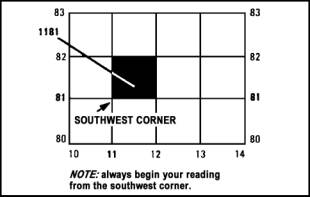
Figure C-11. Grid square 1181
|
|
2.
Determine your address to the
nearest 100 meters. Grid square 1181
gives your general neighborhood, but
there is a lot of ground inside that
grid square. To make your address more
accurate, just add another number to
the first half and another number to
the other half so your address has six
numbers instead of four.
|
a.
To get these extra numbers,
suppose that each grid square has 10
lines inside it running north and
south, and another 10 running east and
west. This makes 100 smaller squares.
You can estimate where these imaginary
lines are (figure C-12).
|
|
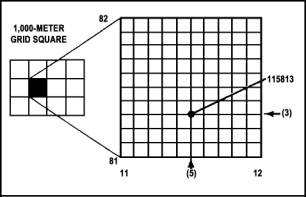
Figure C-12.
Grid square 1181 divided
|
b.
Suppose you are halfway between
grid line 11 and grid line 12. Then
the next number is 5 and the first
half of your address is 115. Now
suppose you are also 3/10 of the way
between grid line 81 and grid line 82.
Then the second half of your address
is 813. Your address would be 115813
(figure C-12). (If you are exactly on
line 81, the second half would be
810.)
|
|
3.
Use a coordinate scale. The
most accurate way to determine the
coordinates of a point on a map is to
use a coordinate scale. You do not
have to use imaginary lines because
you can come up with the exact
coordinates. This scale is on the
coordinate scale and protractor (GTA
05-02-012) (figure C-13) or the
plotting scale (figure C-14). Both of
these devices include two coordinate
scales, 1:25,000 and 1:50,000 meters.
Make sure that when you use either of
these devices, you use the correct
scale.
|
|
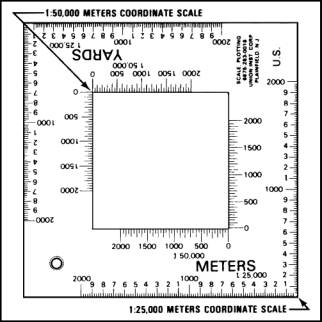
Figure C-13. Coordinate scale and
protractor
|
|
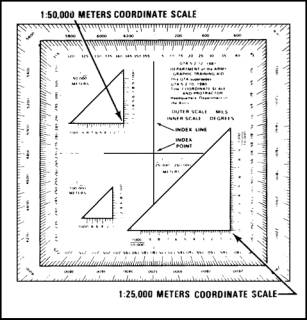
Figure C-14.
Plotting scale
|
a.
Locate the grid square in which
the point is located (for example,
point A, figure C-15) (the point
should already be plotted on the map).
|
b.
The number of the vertical grid
line on the left (west) side of the
grid square gives the first and second
digits of the coordinate.
|
c.
The number of the horizontal
grid line on the bottom (south) side
of the grid square gives the fourth
and fifth digits of the coordinate.
|
d.
Place a coordinate scale on the
bottom horizontal grid line of the
grid square containing point A to
determine the third and sixth digits
of the coordinate.
|
e.
Check to see that the zeros of
the coordinate scale are in the lower
left-hand (southwest) corner of the
grid square where point A is located
(figure C-15).
|
|
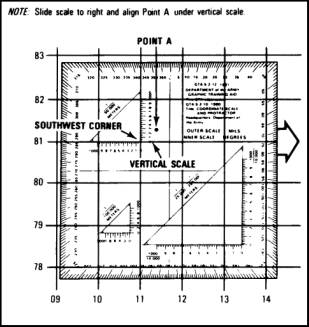
Figure C-15.
Placement of the coordinate scale
|
f.
Slide the scale to the right,
keeping the bottom of the scale on the
bottom grid line until point A is
under the vertical (right-hand) scale
(figures C-16 and C-17). To determine
the six-digit coordinate, the
100-meter mark on the bottom scale,
which is nearest the vertical grid
line, is the third digit of the number
115. The 100-meter mark on the
vertical scale, which is nearest point
A, is the sixth digit of the number
813. Putting these together, you have
115813.
|
|
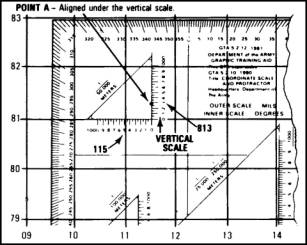
Figure C-16.
Aligning the coordinate scale
|
|

Figure C-17. Aligning the plotting scale
|
g.
To determine the correct
two-letter 100,000-meter-square
identifier, look at the grid reference
box in the margin of the map (figure
C-18).
|
|

Figure C-18.
Grid reference box
|
h.
Place the 100,000-meter-square
identifier in front of the coordinate,
GL115813.
|
Evaluation
Preparation:
Setup:
Give the soldier a standard 1:50,000-scale
military map in a field location, a 1:50,000
grid coordinate scale, a pencil, paper, and
a point on a map for which coordinates must
be determined.
Brief
Soldier: Tell the soldier to write down
the two-letter 100,000-meter-square
identifier and the six-digit grid
coordinates for one point and the two-letter
100,000-meter-square identifier.
|
Performance Measures
|
GO
|
NO
GO
|
|
1.
Determined the six-digit grid
coordinates for the point on the map
with a 100-meter tolerance.
|
—
|
—
|
|
2.
Recorded the grid coordinates
with the correct two-letter
100,000-meter-square identifier.
|
—
|
—
|
Evaluation
Guidance:
Score the soldier GO if all
performance measures are passed. Score the
soldier NO GO if any performance measure is
failed. If the soldier scores NO GO, show
the soldier what was done wrong and how to
do it correctly.
|
References
|
|
|
Required
|
Related
|
|
|
FM
3-25.26
|
|
|
|
GTA
05-02-012
|
|
|